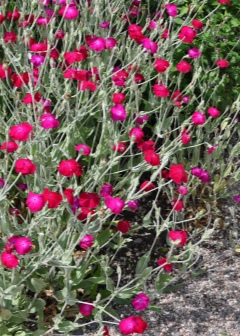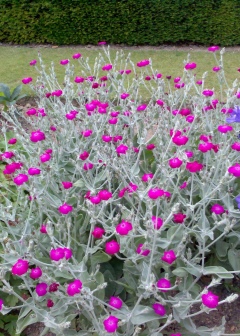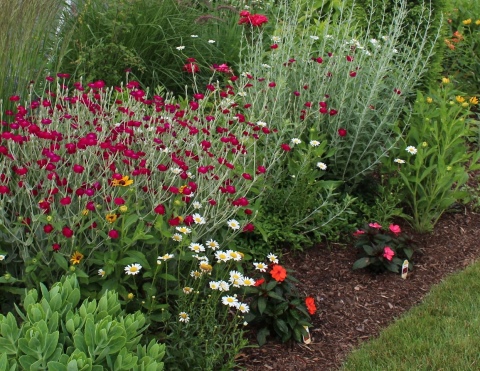Reproduction methods
Like all plants, lychnis can be propagated in several ways. Let's consider them in more detail.
Growing from seeds. If you decide to grow lychnis from seeds on your own, then you need to start in late February or early March. The plant has large seeds, which greatly facilitates the planting process. It is enough to put one seed at a time in a small pot. Then the seedlings are moved to a cool room for 3 weeks. Then you need to move the pots to a warmer room with good lighting. When the seedlings grow up, they are transplanted into larger pots. Regular watering and good lighting will also be needed. Immediately before planting, the plant is hardened for 10-12 days.
Propagation by cuttings. This method is best for terry varieties. At the beginning of summer, you will need to cut cuttings up to 20 cm long.They need to be rooted in a pot or seedling box
In order for the cuttings to take root, it is important to create greenhouse conditions. After the cuttings begin to grow, they must be regularly ventilated.
The transplant is carried out in the fall.
Division of the bush. The procedure is carried out in April or May. On the old plant, shoots form at the roots every year, which makes the bush thicker. You will need to dig up the entire bush and divide it into several parts. It is important that each part contains both shoots and rhizomes. Then the bushes are planted in the chosen place.
In the next video, you will find additional information on planting, care and reproduction of lychnis.
How to care for a plant
In order for the crown lichnis to bloom profusely and delight with its beauty for a long time, it is necessary to follow several rules for care.
Seat selection
The culture in question feels great in a sunny area. There he will give his bloom until the frost. If you plant lichnis in partial shade, it will ruin the decorative effect of the plant.
Many leaves and few buds are formed on it.
But even such a bush will attract attention. The plant can be planted in an open area, as it is not afraid of strong winds and rainfall
Soil and fertilizing
Lychnis koronchaty gives abundant flowering on poorer soil. If there is a lot of organic fertilizers, then the bush begins to grow fat and bloom worse. The flowering period is also reduced. It is necessary to place not humus in the garden soil, but sand. In this case, it is worth choosing such top dressing, which does not contain nitrogen.
It is necessary to irrigate the soil in moderation. If there is excess dampness, then this will become a reason for the development of fungal infections. If the weather is not hot, then watering will be performed once a week. But how to use a sprinkler for irrigation, this information will help you figure it out.
Preparing for winter
In order for the plant to be able to withstand frost, it is necessary to cut off its ground part. But there is absolutely no need to cover the plant with something. As soon as the first snow melts, new shoots, leaves and buds will begin to form.
Pest control
Lychnis crown can be affected by pests and diseases such as aphids, rust and mottling. They arise due to improper care of the plant. If you find any symptoms on the bush, then you need to treat it with special solutions that are sold in the store.
Crowned lychnis is one of the most popular plants of this culture. It has fluffy foliage that has an unusual hue. In addition, the bush is characterized by abundant and bright flowering.Since reproduction can occur in several ways, this allows you to choose the best option for your region.
We also recommend that you read in more detail about growing roses from seeds from China.
Indications for use
For the treatment of ENT diseases
- Rhinitis
- ARI
- Sinusitis
- FLU
- Pharyngitis
- Tonsillitis
- Angina
- Sinusitis
- Acute renit
- Chronic renitis
- Catarrhal otitis media
- Purulent otitis media
- Chronic otitis media
- Acoustic neuritis
For the treatment of neuropathological diseases
- Arthritis
- Occipital neuralgia
- Intercostal nerve neuralgia
- Trinity neuralgia
- Roth-Bernhardt disease
- Vegetative polyneuritis
- Lumbago
- Shoulder-scapular periarthritis
- Epicondelite
- Tenosynovitis
- Knee diseases
- Foot pain
- Diseases of the jaw joint
- Thoracic sciatica
- Acroparesthesia
- Sciatica
- The consequences of a stroke
- Spinal cord injury
- Reno's disease
- Multiple sclerosis
- Myopathy
- Shingles
- Insomnia
For the treatment of dental diseases
For the treatment of eye diseases
- Conjunctivitis
- Blepharitis
- Cicatricial eversion of the eyelids
For the treatment of skin diseases
- Chronic eczema
- Seborrhea
- Psoriasis
- Boils
- Acne
- Wrinkles
- Hair loss
- Postoperative scars
- Warts
- Herpes
For the treatment of gynecological diseases
- Vulvitis
- Descent of the walls of the uterus and vagina
- Cervical erosion
- Frigidity
- Climax
- Endocervitis
- Toxicosis
- Itching of the external genital organs
- Decreased sexual feeling
For the treatment of surgical diseases
- Hemorrhoids
- Hemorrhoids
- Phlebitis
- Rectal prolapse
- Phlebeurysm
- Thrombophlebitis
- Varicose ulcers
- Erysipelas
- Mastitis
- Bedsores
- Ankylosing spondylitis
- Phantom Pain
- Inflammation of the gallbladder
For the treatment of urological diseases
- Inflammation of the urinary tract
- Renal colic
- Spermatorrhoea
- Retention of urine
- Enuresis
- Nephritis, pyelonephritis
- Impotence
When and how it blooms
The flowering time depends on the cultivation of the variety. Usually this period is one and a half months.
- Types of flowers. Flower shapes may vary depending on the variety and variety. Sometimes the petals are straight and sparse, in others they are split into two or four parts. There are also other types of them.
- Flower shapes. In most species, the flower is collected in umbrella-shield inflorescences. But there are those in which they grow in small groups or individual flowers.
- Flowering period. It depends on the type of lychnis. Most varieties have flowers from June to August, and this time lasts for 1.5 months.
- Changes in care during flowering. At this time, the second of the dressings is produced during the season. It must contain all the elements necessary for the growth of flowers. There are no other changes in care.
































